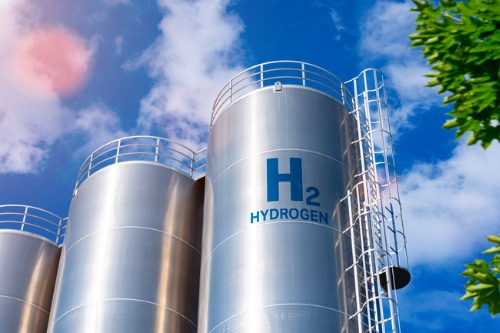HDI insight: Hydrogen - what’s holding it back?

Long seen as a vital tool for decarbonisation, hydrogen has struggled to fulfil its potential. Growth in supply and demand is rising slowly, but both the public and private sectors must do more to overcome economic and infrastructural challenges if hydrogen is to truly boost global sustainability.
Deep in the Australian Outback, miles from the nearest town, a consortium of companies plans to build an energy hub that could transform the world’s largest mining region and beyond. Across an area eight times the size of New York City, 1,700 wind turbines and 10 million solar panels will generate renewable electricity to create 1.6 million tonnes of green hydrogen a year.
Hydrogen has long been touted as a vital solution in the world’s transition to net zero – capable of decarbonising hard-to-abate sectors like heavy industry, transportation and shipping.
Momentum behind the technology is continuing to grow: in its annual report on the sector, released in November, the International Energy Agency (IEA) said demand reached a record high in 2022, with the number of announced projects for low-emission hydrogen production expanding rapidly.
At the recent COP28 summit in December 2023, participants agreed to accelerate the development of low-carbon hydrogen production and streamline international certification schemes. Green hydrogen was a “ubiquitous topic” at the summit due to its wide-ranging potential, said one summary from the Economist.
What is currently unclear, however, is how exactly hydrogen will fulfil this potential and just that percentage of overall hydrogen production will be green – meaning made with renewable electricity rather than natural gas, a fossil fuel. According to the IEA, green hydrogen currently makes up less than one per cent of global hydrogen production. This will need to grow 100-fold by 2030 to meet the IEA’s net zero 2050 scenario.
Prominent members of the private sector are sceptical. In July, the CEO of EDP, one of Europe’s largest utilities companies, said the EU’s aim to produce 10 million tonnes of green hydrogen a year by 2030 were “inflated” and “unrealistic” due to a variety of obstacles.
Short-term scarcity and long-term uncertainty
Fundamentally, the industry faces something of a ‘chicken-and-egg’ problem. Speaking to the Guardian in September, Adrian Odenweller, a scientist at the Potsdam Institute for Climate Impact Research, said the hydrogen market must scale up supply, demand and infrastructure at the same time. “Our research shows that this leads to short-term scarcity and long-term uncertainty of green hydrogen,” Odenweller says, which restricts infrastructure and financing.
According to the IEA, progress on the infrastructure required to make and distribute larger volumes of hydrogen is moving “slowly”. Construction is a long-term process – planning and building a pipeline takes between seven and twelve years, for example. It is hoped that existing infrastructure from the oil and gas sector can be repurposed, but hydrogen can corrode metal pipes, which may make them unsuitable.
Economic hurdles
Of course, building new infrastructure requires financing. But in the current economic climate, equipment and financial costs for hydrogen projects are increasing, and these are extremely capital-intensive from the get-go.
To compound the issue, this has coincided with a fall in natural gas prices. Already cheaper than its green counterpart, the financial incentive to move away from ‘grey’ hydrogen has become even smaller.
In a bid to accelerate progress, public funding for hydrogen projects is now being made available in many regions. But executives at major energy companies, particularly in Europe, have complained that accessing these funds can be a slow and frustrating process.
Companies with hydrogen-related interests in the United States will hope things run more smoothly. In October, the US government announced it will invest USD 7 billion to create seven regional hydrogen-producing hubs. Spread across the country, the hubs will combine old fossil fuel facilities with new buildings that will house electrolyser plants to produce the hydrogen.
A chance to reshape European industry
If green hydrogen does become more widespread, it could transform the international energy landscape. According to consultancy Roland Berger, hydrogen will be distributed around the world, creating new ‘landing ports’ where green energy comes ashore.
In Europe, this could see energy-intensive industries concentrate their footprints on coastal areas to secure supplies of renewable electricity and hydrogen, a process Roland Berger calls “re-regionalisation”. Establishing new industrial hubs could even help slow the gradual de-industrialisation experienced by Europe in recent decades.
Intriguing scientific discoveries
But what if we didn’t even need to make hydrogen to benefit from its clean energy? Scientific discoveries could yet provide a twist in the tale. Until recently, there weren’t thought to be any significant quantities of hydrogen gas, or ‘white hydrogen’, in its pure form within the Earth.
However, earlier this year, French researchers discovered what could be a major hydrogen reservoir thousands of metres below the Earth’s surface. The exact size and location of this reservoir remains unclear – research efforts are ongoing, both in France and elsewhere. But if large, accessible deposits of white hydrogen were found, it could radically shift the needle on hydrogen’s role in the global energy mix.
Urgent action needed
In the meantime, there is an urgent need to step up efforts that address challenges and unlock investments.
The IEA calls on governments in particular to address regulatory barriers for project licensing, implement more ambitious policies to encourage private sector action and make funding more readily available. Hydrogen still has a long way to go to fulfil its potential as a key source of sustainable energy.
Authored by HDI Global
About HDI Global SE
Companies from the trading, production and service industries need an insurance partner they can rely on.
As part of the Talanx Group, HDI Global SE has been one of the leading insurers offering a broad and needs-based range of insurance solutions and accompanying services for decades.
HDI operates through foreign branches, subsidiaries and affiliates as well as network partners in more than 150 countries, offering international industrial insurance programmes.

